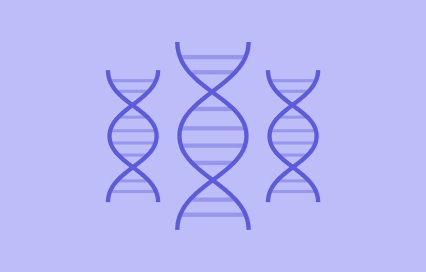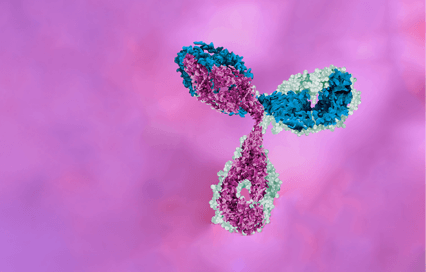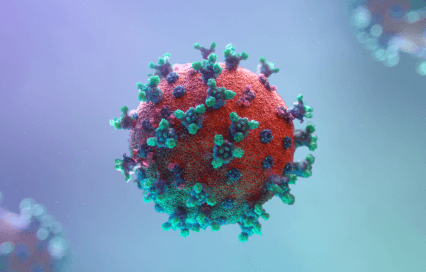
For those in remission from cancer, the threat of relapse looms like a sword over Damocles. Too often, tumor cells will evolve during treatment, accumulating mutations that enable therapeutic resistance and survival when the rest of the malignancy has gone. Though treatment can appear successful, residual cancerous cells may persist below detection thresholds and give rise to new tumors.
Decreasing the threat of recurrence requires a suite of tools that not only make it harder for cancer cells to hide, but also gather data to guide personalized treatment. In short, physicians need the ability to know when cancer is present and to know what treatments are most likely to help each individual patient.
For this, many are turning to circulating tumor DNA (ctDNA). These small fragments of genetic material are leaked into circulation from tumor cells and, when analyzed using PCR or NGS technology, can provide critical information about the existence and origin of cancer cells. The use of ctDNA as a biomarker in minimal residual disease (MRD) testing has the potential to dramatically improve patient outcomes. But like any biomarker, ctDNA is only useful if we can effectively and reliably detect it.
Here, we give a brief overview of ctDNA, its potential as a biomarker in solid-tumor monitoring and MRD testing, and the tools that are needed to realize this potential.
Potential for ctDNA in Managing Solid Tumors
The transformation and growth of cancerous cells is rife with opportunities for DNA to fracture and escape into circulation1. When it does, it has the potential to bring with it both driver and passenger mutations, as well as epigenetic marks that point to its tissue of origin. By sequencing ctDNA fragments, researchers can not only hone in on the malignant tissue’s location, but they can build a mutational profile of the cancer over time. Such information may tell us about the tumor’s therapeutic weaknesses and forewarn of potential resistance mechanisms1-3.
Because DNA can be leaked out of individual cells and carry with it such important information, ctDNA has the potential to be a powerfully sensitive biomarker, particularly for MRD testing.
MRD testing describes efforts to identify residual cancer cells that have survived treatment but remain below the detection threshold of conventional surveillance technologies, such as radiographic imaging. In this context, residual cancer cells may be very few in number and will require highly sensitive assays to detect. Researchers are hopeful that ctDNA analyses may be exactly that, but tapping into this biomarker is far from trivial.
Challenges of Solid-Tumor MRD
Detecting ctDNA from solid tumors is a particularly difficult challenge2,6. Unlike blood (hematopoietic) cancers, ctDNA released from solid tumors will have to permeate tissue and cross vascular barriers before entering circulation. Therefore ctDNA from solid tumors is rare in liquid biopsies.
For MRD, ctDNA may only be 0,1% of total cfDNA
In its most abundant state, mutation-carrying ctDNA may account for only 10% of the cell-free DNA (cfDNA) in a liquid biopsy1,5. When there are very few cancer cells present, such as the residual cells that remain after treatment, informative ctDNA fragments may represent as little as 0,1% of the total cell-free DNA (cfDNA) in a given sample1.
If an assay is able to identify such little material, the next challenge will be to confidently differentiate it from cfDNA. In theory, tumor-derived DNA should be easily distinguished by the presence of mutations. However, non-malignant somatic cell lineages can accumulate mutations that are often linked to cancer. DNA released from these cells may appear to be tumor-derived and lead to a false-positive result6. Specificity then depends on how well the assay is tailored to the patient’s specific mutational profile.
Overcoming challenges in solid-tumor MRD
Several sequencing methods have been developed to overcome the challenges of solid-tumor MRD with a trend towards target enrichment and customized sequencing panels1-3.
Target enrichment panels help significantly boost the sensitivity of sequencing assays. Rather than splitting sequencing resources across a broad range of genetic loci, target enrichment panels use hybridization capture probes to isolate genomic regions of interest before sequencing. This focus allows for deeper sequencing and more sensitive variant detection. As a result, assays using target enrichment have been shown to be 10 times more sensitive than digital PCR and 10 000 times more sensitive than whole genome sequencing1.
Customized target enrichment and sequencing panels help to further improve both sensitivity and specificity. Currently, many MRD tests utilize off-the-shelf, or tumor-naive, panels to specifically amplify ctDNA within patient samples. Though these panels are designed to cover common tumorigenic mutations, they’re not specific for any one patient4. This means that somatic mutations can fool the panel into false positive results, and may be less effective against tumors harboring rare mutations.
To shed these limitations, MRD tests can instead make use of customized panels designed to specifically enrich and amplify sequences that are known to be uniquely present in a patient’s tumor (a tumor-informed approach to MRD). In this scenario, sequencing a tumor biopsy prior to or during treatment can provide a detailed mutational profile of the tumor. That data can then be used to build target capture and sequencing probes that precisely match the tumor genome4.
The use of target enrichment and tumor-informed MRD panels is gaining momentum7, particularly as companies like Twist Bioscience continue to redefine what’s possible in synthetic biology.
Twist Bioscience Enables Solid Tumor MRD Research
For solid tumor MRD, precise and uniform oligonucleotide synthesis is critical.
🧬 Precision and Uniformity in MRD
Detecting miniscule amounts of ctDNA will be much harder if your tools are flawed.
For example, target capture panels rely on the complementary binding of hybridization probes to target ctDNA sequences. Errors during probe synthesis can reduce binding affinity between probes and their targets, resulting in reduced sensitivity at best or false-negative results at worst. Therefore precise oligo synthesis is critical to sensitive ctDNA detection.
Similarly, when the individual probes in a panel are not synthesized uniformly (in equal numbers), some enriched ctDNA targets will be over-sequenced and others under-sequenced. Overcoming this bias requires additional sequencing to ensure the absence of a target is not simply due to an underrepresented probe. Doing so increases sequencing costs and may still result in reduced sensitivity.
Using a silicon-based platform that synthesizes DNA with exceptional throughput, precision, and uniformity, Twist Bioscience is an industry leader in oligonucleotide synthesis. Twist specifically synthesizes hybridization capture probes for targeted sequencing applications, including MRD detection.
Recently, Twist launched the Twist MRD Rapid 500 Panel to enable researchers to develop sensitive tools for MRD detection. This panel can be customized based on a target tumor’s mutational profile with the ability to target up to five hundred mutations per test. The custom panel includes enough probes for up to twelve tests, making it amenable to repeated testing over time (longitudinal testing).
Detecting ctDNA is never easy, but with high-quality tools built by Twist, the job gets a little bit easier. Learn more about how Twist is expanding the NGS toolkit for cancer detection, or contact our team to discuss how Twist can help power your MRD research.
References
- Chin, Re-I, et al. “Detection of Solid Tumor Molecular Residual Disease (MRD) Using Circulating Tumor DNA (CtDNA).”Molecular Diagnosis & Therapy, vol. 23, no. 3, 2 Apr. 2019, pp. 311–331, 10.1007/s40291-019-00390-5. Accessed 6 July 2022.
- Larribère, Lionel, and Uwe M. Martens. “Advantages and Challenges of Using CtDNA NGS to Assess the Presence of Minimal Residual Disease (MRD) in Solid Tumors.”Cancers, vol. 13, no. 22, 14 Nov. 2021, p. 5698, 10.3390/cancers13225698. Accessed 12 Feb. 2022.
- Honoré, Natasha, et al. “Liquid Biopsy to Detect Minimal Residual Disease: Methodology and Impact.”Cancers, vol. 13, no. 21, 26 Oct. 2021, p. 5364, 10.3390/cancers13215364. Accessed 14 Apr. 2022.
- Moding, Everett J., et al. “Detecting Liquid Remnants of Solid Tumors: Circulating Tumor DNA Minimal Residual Disease.”Cancer Discovery, vol. 11, no. 12, 1 Dec. 2021, pp. 2968–2986, 10.1158/2159-8290.cd-21-0634. Accessed 6 July 2022.
- Phallen, Jillian, et al. “Direct Detection of Early-Stage Cancers Using Circulating Tumor DNA.”Science Translational Medicine, vol. 9, no. 403, 16 Aug. 2017, stm.sciencemag.org/content/9/403/eaan2415, 10.1126/scitranslmed.aan2415. Accessed 25 Aug. 2021.
- Spoor, Jonathan, et al. “Liquid Biopsy in Esophageal Cancer: A Case Report of False-Positive Circulating Tumor DNA Detection due to Clonal Hematopoiesis.”Annals of Translational Medicine, vol. 9, no. 15, Aug. 2021, pp. 1264–1264, 10.21037/atm-21-525. Accessed 21 Nov. 2021.
- Bent, Alisha, et al. “The Future of CtDNA-Defined Minimal Residual Disease: Personalizing Adjuvant Therapy in Colorectal Cancer.”Clinical Colorectal Cancer, Mar. 2022, 10.1016/j.clcc.2022.03.004. Accessed 2 2022 年 5 月.
Qu’en pensez-vous ?
J’aime
bien
2
Je n’aime pas
0
J’aime beaucoup
1
Je suis surpris(e)
0
C’est intéressant
1








